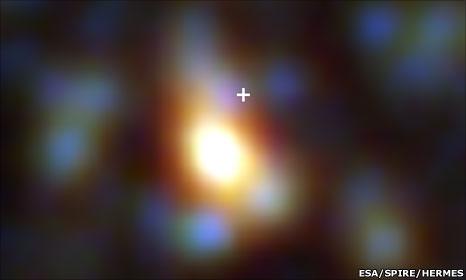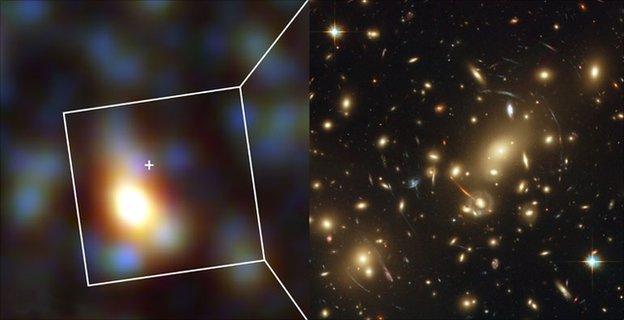Herschel telescope spies galaxy with cosmic 'zoom lens'
- Published

The distant galaxy (bright yellow) is seen as it was 11 billion years ago
Europe's Herschel space telescope has spied a far-distant galaxy with the aid of a cosmic "zoom lens".
The observatory is already one of the most powerful astronomical tools ever built, but its abilities can be boosted thanks to a neat trick of gravity.
By viewing a huge cluster of galaxies, Herschel has been able to study in detail an even more distant object.
This is possible because the gravity of the foreground cluster magnifies the light of the background galaxy.
In a new picture released by the European Space Agency (Esa), this far-off galaxy is seen just a couple of billion years after the Big Bang.
"If the cluster were not there, we might not be able to see the galaxy," commented Professor Seb Oliver from the University of Sussex, UK.
"It would certainly have appeared much, much fainter; and we think we are seeing back to an epoch of really important star formation," he told BBC News.
The gravitational lensing technique has famously been used in the past by the Hubble Space Telescope, and it was to an old Hubble lens that Herschel turned on this occasion.
Abell 2218 is a colossal aggregation in space some two billion light-years from Earth in the northern constellation Draco.
Its compact mass is equivalent to many thousands of galaxies, and this huge concentration of matter distorts and maximises the light from the objects that sit behind it.
The way this natural zoom lens in the sky works is a beautiful consequence of Einstein's General Theory of Relativity.
In Hubble's images of Abell 2218, far-distant galaxies appear as multiple arcs and arclets smeared across the field of view.
In Herschel's observation of the same scene using its Spire instrument, the distant galaxies appear as slightly fuzzy blobs. The bright yellow blob in the centre of the new Herschel image is a galaxy seen as it was 11 billion years ago.
The differences in the Hubble and Herschel pictures are a direct consequence of the varied wavelengths at which the two telescopes operate.
Hubble sees the Universe in the optical and near-infrared, and these wavelengths produce very sharp forms in the telescope's images.
HERSCHEL AND HUBBLE VIEW THE ABELL 2218 GALAXY CLUSTER

The huge concentration of matter in Abell 2218 distorts and magnifies the light from the objects that sit far behind it
In Hubble's image of Abell 2218 (right), these distant galaxies are seen as multiple arcs that smear across the field of view
In Herschel's image (left), Abell 2218 is centred on the cross-hair. Most Hubble features are transparent at Herschel wavelengths
The large yellow blob just below the cross-hair is a distant galaxy. Its light has been boosted by the foreground cluster
This far-off galaxy is seen as it was about 2.6 billion years after the Big Bang, providing a glimpse into early star formation
Other structures that can be seen in the image (blue blobs) are also galaxies, but these are in the foreground cluster
The two pictures demonstrate how the Hubble and Herschel space telescopes can be used together to probe the Universe
Herschel, on the other hand, is sensitive to much longer wavelengths, in the far-infrared and sub-millimetre range, and its pictures are naturally much softer.
But it is this ultra-long-wavelength sensitivity that allows Herschel to see the processes that initiate star formation in clouds of very cold gas and dust - a perspective completely hidden from Hubble.
Dr Michael Zemcov of the California Institute of Technology says: "Images like this show that Spire has opened up the possibility of observing at sub-mm wavelengths in a way that was just not possible before; this kind of clarity is unprecedented at these wavelengths.
"Now that these data are available to the entire astronomical community, we will really be able to test our understanding of objects like galaxy clusters and, more profoundly, the formation of structure in the Universe from soon after the Big Bang right up to the present day."
The new imagery is part of the Herschel Multi-tiered Extragalactic Survey (HerMES), a project to study the evolution of galaxies in the distant Universe.
It is the largest project using Herschel data.
The European Space Agency's billion-euro observatory was sent into orbit on an Ariane rocket on 14 May last year.
It is positioned far from Earth to give it an unobstructed view of deep space.